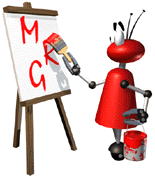
Chris Adams
MOBILE ROBOTICS RESEARCH GROUP
learning by imitation
Contact: Yuval Marom
Last updated: Wed Apr 10 10:01:27 2002
Current researchers
Previous researchers
Learning by Imitation
We do not exist alone. Humans and most other animal species live in societies where the behaviour of an individual influences and is influenced by other members of the society. Within societies, an individual learns not only through classical conditioning and reinforcement, but in large extent through observation and imitation. We are concerned with how to add such learning mechanisms to artificial agents, including simulated and mobile robots.We are investigating the following:
- what is the imitation process? what are some possible computational mechanisms? (see below)
- attention in the imitation process
- learning communication skills through imitation
The work that started this project off involved experiments on how to make a robot observe, imitate, and learn from another robot or human. This work was inspired by several fields including developmental psychology, biology, and neurophysiology.
- A Robot Controller Using Learning by Imitation. G.M. Hayes and J. Demiris, Proceedings of the 2nd International Symposium on Intelligent Robotic Systems, Grenoble, France, July 1994
- Imitative Learning Mechanisms in Robots and Humans. John Demiris and Gillian Hayes, in V. Klingspor (editor), Proceedings of the 5th European Workshop on Learning Robots, Bari, Italy, July 1996. Also available as DAI Research Paper 814, Department of Artificial Intelligence, University of Edinburgh, Scotland.
For more detail on imitative learning mechanisms, visit John Demiris's and George Maistros' homepages.
From this early work emerged the question of when should an agent decide to imitate? under what conditions is the presented stimulus worth further processing, eventually ending up in learning? This could be treated as an issue of attention. At least two factors are involved here:
- internal motivations and needs
- influence from the social environment
Attentional Mechanisms for Imitative Learning
In social learning, an individual benefits from interacting with its social environment, to acquire new competencies and skills. In other words, the existence of one or more other individuals in its perceived environment, aids an individual to learn as it negotiates unknown environments. Psychologists use the term "social enhancement" to refer to all social influences on an individual's performance. One form of such influence is "local enhancement" or "stimulus enhancement", where one (or more) individual - the teacher - actively manipulates the perceived environment of another - the learner, either by moving objects in the environment, or changing its own location, configuration, orientation etc'.
The purpose of these manipulations is to direct the attention of the learner to the relevant stimuli of the task to be learned. In learning by imitation, a student agent learns by imitating a teacher agent, and then associating its perceived environment with the motor commands that it had to execute in order to imitate. The next time the student finds itself in a similar situation, it can execute the commands it has associated, and hence perform the correct actions. Hopefully, by having the student's attention focused on the relevant features of the environment associated with the task at hand, and at the right time, the amount of storage required for representation and memory is reduced, and therefore the speed of learning is increased.
We are interested in modelling perception of change that is necessary to determine when it is worthwhile (for the agent) to pass information from perception, on to further processing and storage in memory, ie learning. We do this by providing our agent with a concept of significance of stimuli, and designing a strategy whereby the agent can adapt its own criterion for the significance of stimuli that will be worth further processing, based on built-in attentional capacity. See the following papers for more detail:
- Towards a Model of Temporal Attention for On-line Learning in a Mobile Robot. Yuval Marom and Gillian Hayes. Invited paper to appear in Daniel Dubois, editor, Proceedings of the Fourth International Conference on Computing Anticipatory Systems (CASYS 2000), Liege, August 2000.
- Perception of change for a socially enhanced robot imitator. Yuval Marom and Gillian Hayes. In Proceedings of Autonomous Agents 2000, Barcelona, June 2000.
- Maintaining Attentional Capacity in a Social Robot. Yuval Marom and Gillian Hayes. In Proceedings of Autonomy Control: Lessons from the Emotional, a Symposium at the 15th European Meeting on Cybernetics and Systems Research. Vienna, April 2000.
To summarise, we are investigating how what we call "attention", together with social interactions, can help a mobile robot learn from other agents, robotic or human.
For more papers, visit Yuval Marom's homepage.
Learning to Communicate
In previous work, a set of experiments investigated learning to communicate through imitation. See
- `Robot's first steps, Robot's first words ...'. Aude Billard and Gillian Hayes. In the proceedings of GALA'97 conference, Edinburgh, 4-6 April 97.